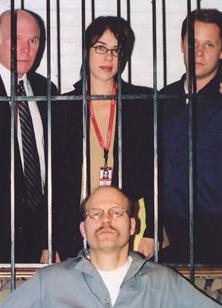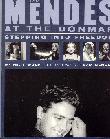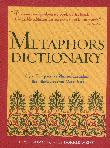SITE GUIDE
SEARCH
REVIEWS
REVIEW ARCHIVES
ADVERTISING AT CURTAINUP
FEATURES
NEWS
Etcetera and
Short Term Listings
LISTINGS
Broadway
Off-Broadway
NYC Restaurants
BOOKS and CDs
OTHER PLACES
Berkshires
London
California
New Jersey
DC
Philadelphia
Elsewhere
QUOTES
TKTS
PLAYWRIGHTS' ALBUMS
LETTERS TO EDITOR
FILM
LINKS
MISCELLANEOUS
Free Updates
Masthead
Writing for Us
A CurtainUp Review
In the Belly of the Beast Revisited
By Elyse Sommer
|
It began on January 21, 1944, thirty-eight years ago tomorrow. That is when Jack Henry Abbott was born. And he went from the belly of his mother directly into the belly of the beast. I mean from one womb into another. I mean from the moment of inception, he was put in jail, not an infirmary, not an incubator, nothing like that. Directly into jail. They called it foster homes. ---Reader 1 as Defense attorney during Abbott's trial for the manslaughter, just six months after his parole that owed much to Norman Mailer's support. |

Front: David Mogentale as John Henry Abbott. Rear: James E. Smith, Heidi James & Gordon Holmes
(Photo: Fouad Salloum)
|
The play, In the Belly of the Beast Revisited is based on the book that grew out of Abbott's prison correspondence with Norman Mailer who was so seduced by its vividness that he became an advocate for the publication of the letters and Abbott's release from prison. The "Revisited" differentiates this from an earlier dramatization in the early 1980s in that it is a new adaptation by Adrian Hall that delves deeper into Abbott's psyche by incorporating material from Abbott's second book (My Return, 1987) and various court records, newspaper, radio and TV accounts that take us right up to his prison suicide..
Under Leo Farley's vigorous direction and with a strong assist from set designer Mark Symczak, the small stage handily accommodates the shifts between harrowing prison and courtroom drama -- the letter genre embracing a parole board meeting and the widely publicized trial that sent Abbott back to prison after he stabbed a young waiter just a few weeks before the end of his probation. With the three supporting actors, listed only as Readers 1, 2 and 3, you may think this is a sort of illustrated staged reading, but Farley adeptly steers those readers through a variety of other characterizations; e.g.: prison guards, a court stenographer, defense and prosecuting attorneys, Norman Mailer, the hapless waiter Abbott stabbed to death and his companions on the night of that fateful encounter.
Heidi James, James E. Smith and Gordon Holmes skillfully handle their multiple roles. It's nice to see Ms. James once again after her standout performance in the company's Fall 2003 production of Rona Munro's Bold Girls (An interesting aside: That production coincided with Manhattan Theater Club's mounting of Munro's Iron, which happened to be a prison play).
Good as the support players are and much as their roles contribute to this play transcending the label of docudrama, the evening belongs to Mogentale, sporting wire rimmed glasses and a mustache to validate Abbott's half Asian background, gives a bone-chillingly complex performance. His recollections of a life lived almost entirely in reformatories and prisons are recreated with a controlled intensity that makes the first act almost too painful to watch. As he relives his time spent in the hell known as the Hole he takes you with him into its utter blackness. He curls up in a fetus-like ball on the floor as he recounts a brutal beating. The actor's powerful athleticism replaces words as a guard unfeelingly conveys news of the death of his mother and he repeatedly throws himself against a metal cabinet. (While he apparently had good feelings about his mother, the details of how sheabondoned him to foster care are vague.)
As in the recently opened Bug by Tracy Letts (in whose Killer Joe Mogentale played the title character in 1994), the prison recollections include some pretty unsettling talk about cockroaches -- but while Bug is also dark and unlikely to please light entertainment seekers, it IS a comedy. In The Belly of the Beast Revisited is served straight up, without any tension relieving chuckles.
While Mogentale's characterization makes makes us uncomfortably aware of how an uncaring system contributes to rather than corrects criminality, he also captures Abbott's knack for self-justification, as in this letter to Mailer: "You're not a 'psycho,' a killer. That doesn't mean you won't kill, you won't do mind-boggling acts of violence. It is hard to bring yourself to these acts, but you take a deep breath, look intelligently at what you must do, and you do it even though you are scared stiff and sick to your stomach." His almost sensual description of another inmate's knife killing of a guard and his own similar act is a sad signal of the killer instinct that people like Mailer failed to recognize as something that would predictably surface when Abbott found himself free and a literary celebrity even as he still lived as a parolee in a seedy New York halfway house. This dual picture of a man who wins your sympathy as someone whose potential was allowed to fall between the cracks but who is unable to turn his talent and anger into a more redemptive story becomes even more apparent during the less physically but no less emotionally lacerating trial of the second act.
Vera Beren's rat-tat-tat sound design and music intensify the unflinching grimness of Abbott's sadly wasted life. Stewart Wagner's lighting demarcates the two simultaneously visible settings and adds immeasurable to the atmosphere.
Unlike the just closed Exonerated, which was more upbeat in that it shows at least some changes in the justice system that has freed or exonerated scores of unjustly convicted people, In the Belly of the Beast Revisited is tough and unbending as the steel doors of a prison cell in its depiction of one man who had enough writing ability to leave a record of a story that is undoubtedly one of thousands -- a story for which this play offers no alternative endings. Needless to say, it's is not for the faint of heart.
Notes and Links
In an article written by Philip Terzian for Jewish World Review(Feb. 15, 2002) after Abbott hanged himself in his cell, the author posits that "IF Jack Henry Abbott did nothing else in his life, he put an end to the budding romance between public intellectuals and murderers" Another writer, Sid Smith of the Chicago Tribune, in writing about a 1985 production of the play quoted Norman Mailer's admission that he felt "a very large responsibility" for the knifing committed during Abbott's parole. Smith does point out that Mailer's guilt must have still been mixed with sympathy since he was in daily attendance at the 1982 trial, as was Susan Sarandon who shortly thereafter named her newborn son Jack Henry!
LINKS TO PLAYS MENTIONED
Bold Girls
The Exonerated
Iron
The Glory of Living-- not mentioned in my review but probably the prison drama which comes closest to matching the grim and grungy sensibility of In the Belly of the Beast Revisited.
| IN THE BELLY OF THE BEAST REVISITED
Written by Jack Henry Abbot; arranged and edited by Adrian Hall Directed by Leo Farley Cast: David Mogentale as Abbott; with Gordon Holme, s Heidi James and James E. Smith as Readers and various characters . Set Design: Mark Smyczak Costume Design: Christopher Lione Lighting Design: Stewart Wagner Sound Design: Vera Beren Running time: 1 hour and 50 minutes, including one 10-minute intermission 29th Street Rep, 212 W. 29th St. (7/8th Aves) www.29thstreetrep.com SmartTix 212-868-4444 2/23/04 to 4/03/04; opening 3/08/04. Mon to Sat at 8pm. Tickets, $40. Reviewed by Elyse Sommer based on 3/05/04 press performance |

Mendes at the Donmar
Our Review

At This Theater

Leonard Maltin's 2003 Movie and Video Guide

Ridiculous!The Theatrical Life & Times of Charles Ludlam

Somewhere For Me, a Biography of Richard Rodgers

The New York Times Book of Broadway: On the Aisle for the Unforgettable Plays of the Last Century

6, 500 Comparative Phrases including 800 Shakespearean Metaphors by CurtainUp's editor.
Click image to buy.
Go here for details and larger image.



